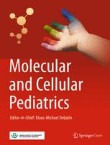The BPD trio? Interaction of dysregulated PDGF, VEGF, and TGF signaling in neonatal chronic lung disease
The development of neonatal chronic lung disease (nCLD), i.e., bronchopulmonary dysplasia (BPD) in preterm infants, significantly determines long-term outcome in this patient population. Risk factors include m...
